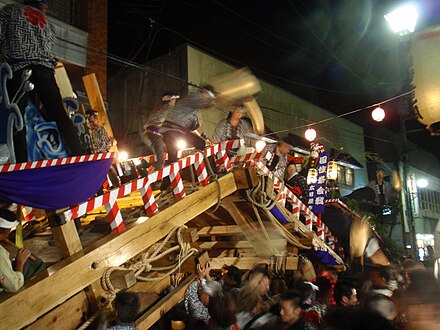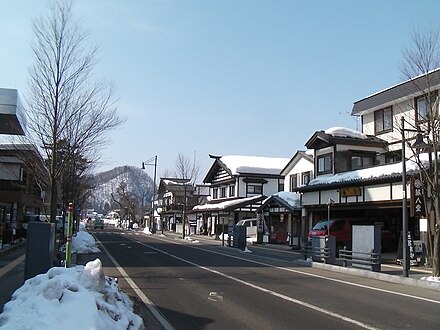Kakunodate - dissolved municipality in Senboku district, Akita prefecture, Japan
Kakunodate is a town in Semboku, Akita. Known as Samurai town (武家屋敷) and "The Little Kyoto of Tohoku".(みちのく小京都).
Understand
In 2005, Kakunodate, along with the town of Tazawako, and the village of Nishiki were merged to create the city of Semboku.
Get in
The Akita Shinkansen Komachi (こまち) running between Tokyo and Akita, via Sendai and Morioka, makes a regular stop at the JR Kakunodate station every hour. The journey takes roughly 4 hr from Tokyo, 2½ hr from Sendai and 1 hr from Morioka or Akita. Make sure to book your seat in advance, as all seats on Komachi trains are reserved and station staff may be busy when the train arrives. The Japan Rail Pass is accepted.
Get around
Walking is really the only viable option in this small, compact city.
See
Kakunodate is well known for well preserved Samurai houses scattered around along Bukeyashiki Street (which means Samurai House Street) and forming as a Bukeyashiki Samurai District. Some of these houses are open to public.
- Samurai houses (dead link: December 2020)
- Aoyagi House. Apr-Oct 09:00-17:00, Nov-Mar 09:00-16:00. ¥500
- Ishiguro House, 39.601198°, 140.561678°. 09:00-17:00. ¥300
- Odano House. Mid Apr-Oct 09:00-17:00. Free
- Kawarada House. Mid Apr-Oct 09:00-17:00. Free
- Iwahashi House, 39.598686°, 140.562735°. Mid Apr-Oct 09:00-17:00. Free
- Matsumoto House. Mid Apr-Oct 09:00-17:00. Free
- Kakunodate Castle Ruins (古城山), Furushiroyama, Kakunodate-machi, 39.60671°, 140.56269°. Pile of old castle ruins. Castle tower does not remain, only stone wall remains.
- Cherry Blossom. Best time to see late-Apr - early- May.. There are 400 Prunus yedoensis (ソメイヨシノ) trees on the embankment of Hinokinai River spans 2 km, and 150 Prunus pendula (シダレザクラ) trees in Samurai town street.
Do

- Festival of Kakunodate (角館のお祭り). Will be held on 7 to 9 September every year. Festival has a history of 350 years. Many floats to move the town. People traditional dancing to continue behind the floats. When floats run into each other on the street, claiming the priority in the way that they hit each other floats.
- Fire and Snow Festival (火振りかまくら Hiburi Kamakura), +81 187 54-2700. Feb 13-14, starts at 17:00. In a sort of purification ritual, people whirl flaming pieces of straw on a string above their heads. Onlookers can participate if they like. If so, a hat covering one's hair is a good idea.
- The Sasara Dance of Kakunodate. "Sasara" is the local dialect for the traditional Lion Dance. The name comes from the sasara - wooden instruments placed during the dance. The dance's origins go back four hundred years, when the new lord Stake, arriving in exile from the south, had the dance performed in advance of his procession in order to drive away malevolent spirits. Now it is part of local O-Bon celebrations (mid-August), danced as a prayer for a good harvest and good health. 2016-08-14
Buy
Kakunodate is famous around Japan for its cherry bark crafts which are sold at just about every store in the town.
Eat
- Sakura no Sato (桜の里), 9 Higashi-Katsuraku-cho, Kakunodate 角館町東勝楽丁9番, 39.597374°, 140.562298°, +81 187 54-2527. 09:00-17:00. Located in the Samurai town. Bowl of rice topped with chicken and eggs used the Hinaijidori (比内地鶏を使った親子丼) ¥1575. Inaniwa Udon ¥840.
Drink
Sleep
- Guesthouse Fūga (ゲストハウス風雅), 34-8, Kodate, Kakunodate, 角館町小館34-8 (15-min walk from Kakunodate station), 39.590874°, 140.5617°, +81 187 54-2784, eikomiura66@gmail.com. Check-in: 16:00, check-out: 11:00. Inn only without meals. ¥4000 (High season +α)
- Sakura no Sato (民宿桜の里), 52, Hosogoe-machi, Kakunodate 角館町細越町52, 39.602144°, 140.562895°, +81 187 55-5652. Minshuku by Japanese-style buildings. It is in the northeast of Samurai town. Stay +2 meals ¥7000+
Go next
- Lake Tazawa. Japan's deepest lake.
- Nyuto Onsen. Tohoku's secret spa resort in the deep forests of Akita Kogen Plateau.
- Daisen
- Akita
- Yokote
- Ugo
- Yuzawa
- Senboku
- Nishiwaga
Kakunodate
Date Time:Please wait...Timezone:Asia/TokyoPopulation:14,138Coordinates:39.60, 140.56
Semboku
2nd-order administrative division
Akita Prefecture
Primary administrative division
